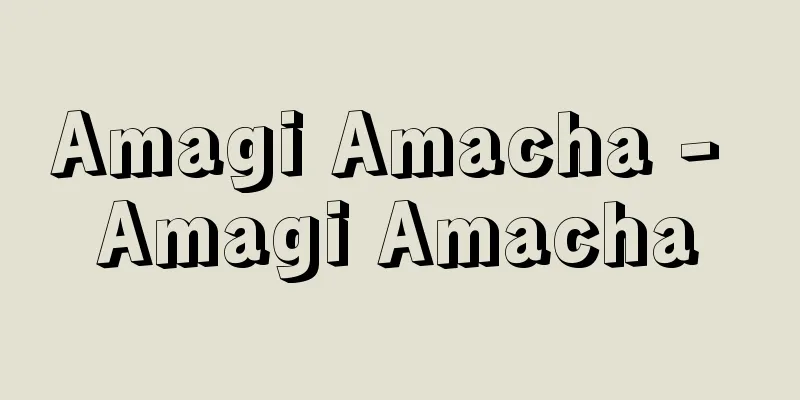Ondo - Ondo

|
(1) Refers to the lead player of each instrument in gagaku, especially the three instruments of hichiriki, ryuteki (flute), and sho, and the lead performer in shomyo. Originally an elder, this role plays a leading role in ensembles and choruses. The other performers are called "join." Generally, gagaku pieces begin with a solo performance of the ryuteki, followed by an ensemble at the "join tsukedo," and finally a "domete" performance by the ondo of each instrument. In "netori" and "nokorigaku," the ondo of the three instruments is played together with the biwa and so, and the skill of each instrument is competed. In shomyo, this is also simply called "to." It begins with a solo performance of the ondo, followed by singing in unison at the "tsukedo." If there is instrumental accompaniment, it is added at this point. [Yoko Hashimoto] (2) One of the names of the way Japanese folk songs are performed. Because a chant begins with a solo singing of the ondo, and multiple people join in the unison singing at the attached part, songs in the form of a dialogue also came to be called ondo. Therefore, many ondo-style songs, such as kiyari songs and bon odori songs, which are used to unify the actions of a large number of people, became song titles as they were. Examples are "Aikawa ondo," "Ise ondo," and "Kawachi ondo." However, since many of these song titles, such as bon odori songs, are sung and danced to, new folk songs (local songs based on original folk songs) that began at the end of the Taisho period (1912-1926) that were lively and accompanied by dancing came to be named "○○ ondo." A representative song of this type is "Tokyo ondo." [Tsutomu Takeuchi] Source: Shogakukan Encyclopedia Nipponica About Encyclopedia Nipponica Information | Legend |
|
(1)雅楽における各楽器、とくに篳篥(ひちりき)・竜笛(りゅうてき)(横笛(おうてき))・笙(しょう)の三管の主奏者、および声明(しょうみょう)における主唱者をいう。元来長老格の者があたり、合奏・合唱の主導的役割を果たす。これに対し他の者を「助音(じょいん)」という。一般に雅楽の楽曲では竜笛の音頭の独奏で始まり、「助音付所(つけどころ)」から合奏、最後は各管の音頭で「止め手」を奏すことが慣習化している。「音取(ねとり)」や「残楽(のこりがく)」は三管の音頭と琵琶(びわ)・箏(そう)で合奏され各楽器の妙技が競われる。声明では単に「頭(とう)」ともいう。音頭の独唱で始まり、「付所」から斉唱。楽器の伴奏がある場合もここで加わる。 [橋本曜子] (2)日本民謡の演奏方法の名称の一つ。声明が音頭の独唱で始まり、付所の部分から複数以上の人々の斉唱が加わるところから、広く掛合い形式の唄(うた)も音頭とよばれるようになった。したがって、大ぜいの人々の行動を統一させるための木遣(きやり)唄、盆踊り唄などに音頭形式のものが多く、それがそのまま曲名にもなった。『相川(あいかわ)音頭』『伊勢(いせ)音頭』『河内(かわち)音頭』などがそれである。ところが、盆踊唄のように、この曲名には歌って踊るものが多いことから、大正末から始まった新民謡(創作歌謡による御当地ソング)の曲名のうち、にぎやかで踊り付きのものには「○○音頭」と命名するに至った。その代表曲が『東京音頭』である。 [竹内 勉] 出典 小学館 日本大百科全書(ニッポニカ)日本大百科全書(ニッポニカ)について 情報 | 凡例 |
Recommend
Theory of social organism
This is a view of society that compares society t...
Dorokyo - Dorokyo
This gorge is the Kitayama River, a tributary of ...
Humulus scandens (Lour.) Merr.
An annual vine of the Cannabaceae family that grow...
Shima [town] - Island
A former town in Shima District, eastern Mie Prefe...
Simple fireproof building - Kantaiikakenchiku
...For example, in the case of coated steel struc...
Gymnastique - Gymnastique
…It was in the first half of the 19th century tha...
Pseudomonas
Also called Pseudomonas or Pseudomonas. A genus of...
Otone Irrigation Canal
This is agricultural water for the northeastern p...
Inhasshi - Inhasshi
…The area of the inner vassalage was the basin ...
Otaria byronia; South American sea lion
Order Carnivora, Suborder Pinnipedia, Family Otari...
Kazan Tatars
...In the 15th and 16th centuries, when the Golde...
Red Tomoe - Red Tomoe
…The larvae feed on the leaves of the silk tree. ...
Falconer - Takajo
〘noun〙① A person who captures and raises falcons. ...
Eihoji Temple Garden
...A temple of the Rinzai sect of the Nanzenji sc...
Common First Examination - Kyotsuuichijishiken
This unified test was conducted nationwide from 1...






![Tsunagi [town] - Connecting](/upload/images/67cc3ca5a88cd.webp)


